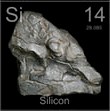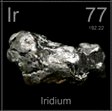Wednesday, 4th February 2015 – Chemical Elements part 2 – this was a joint effort by 6 of our members, each talking for 10 minutes on their chosen element. It was the second session on chemical elements, the first one being last June. February’s line-up was:
Frank Wood – Silicon
John Appleton – Lead
Ann Parker – Hydrogen
Allan Yates – Polonium
Bill Hale – Iridium
Sue Watkinson – Gold
Each of the presenters took a different approach, which provided great variety.
Frank outlined the zone refining of silicon, its crystal structure,  and its major uses. He then went on to explain how silicon acts as a semi-conductor when doped with either nitrogen or phosphorus atoms and is the basis of the transistor.
and its major uses. He then went on to explain how silicon acts as a semi-conductor when doped with either nitrogen or phosphorus atoms and is the basis of the transistor.
 John described the harmful effects of environmental lead in the development of children’s teeth, with particular reference to a project he has worked on in Poland monitoring the levels of lead over time.
John described the harmful effects of environmental lead in the development of children’s teeth, with particular reference to a project he has worked on in Poland monitoring the levels of lead over time.
On a lighter note (you can’t get much lighter than hydrogen!), Ann  explained the critical importance of hydrogen bonds in biology and how they enable life as we know it.
explained the critical importance of hydrogen bonds in biology and how they enable life as we know it.
 Allan talked about the discovery and properties of polonium, one of the most radioactive and toxic substances around, and its role in the killing of the former soviet secret service agent Alexander Litvinenko.
Allan talked about the discovery and properties of polonium, one of the most radioactive and toxic substances around, and its role in the killing of the former soviet secret service agent Alexander Litvinenko.
 Bill’s interest in birds and geology suggested iridium, which is found in meteorites with an abundance much higher than its average abundance in Earth’s crust. For this reason the unusually high abundance of iridium in the clay layer at the Cretaceous–Paleogene boundary gave rise to the Alvarez hypothesis that the impact of a massive extraterrestrial object caused the extinction of dinosaurs and many other species 66 million years ago.
Bill’s interest in birds and geology suggested iridium, which is found in meteorites with an abundance much higher than its average abundance in Earth’s crust. For this reason the unusually high abundance of iridium in the clay layer at the Cretaceous–Paleogene boundary gave rise to the Alvarez hypothesis that the impact of a massive extraterrestrial object caused the extinction of dinosaurs and many other species 66 million years ago.
 Sue rounded off the mini-talks with an interesting account of the early history of gold and its uses through the centuries right up to the present day use in electronics, medicine and space exploration.
Sue rounded off the mini-talks with an interesting account of the early history of gold and its uses through the centuries right up to the present day use in electronics, medicine and space exploration.
I venture to suggest that the seventy-eight people who came along not only enjoyed the talks, but also went away knowing something extra about six more of our chemical elements.
 at Christmas! With a festive assortment from Jack, Chris, Edmund and Patsy, you can be assured of a heart-warming afternoon:
at Christmas! With a festive assortment from Jack, Chris, Edmund and Patsy, you can be assured of a heart-warming afternoon:![mobile-phone-150x150[1]](https://aou3ascience.wordpress.com/wp-content/uploads/2015/11/mobile-phone-150x1501.jpg?w=584)
![sunbed-150x150[1]](https://aou3ascience.wordpress.com/wp-content/uploads/2015/11/sunbed-150x1501.jpg?w=584)
![2000px-Structure_of_the_magnetosphere-en.svg[1]](https://aou3ascience.wordpress.com/wp-content/uploads/2015/09/2000px-structure_of_the_magnetosphere-en-svg1.png?w=584&h=449) Is the magnetic shield constant or does it change, can it collapse completely? What do we know about the behaviour of the magnetic field in the past? What could happen to civilisation if the field decreases? The answers to these and many other questions can be found in the ancient recordings stored in ceramics and rocks. John Shaw gave us a fascinating account of how the earth’s magnetic field protects us from harmful rays and particles ejected from the surface of the sun, and went on to explain what might happen if the magnetic field disappeared. He rounded off the talk by showing us how to make a DIY megnetometer, mainly using a handful of household objects.
Is the magnetic shield constant or does it change, can it collapse completely? What do we know about the behaviour of the magnetic field in the past? What could happen to civilisation if the field decreases? The answers to these and many other questions can be found in the ancient recordings stored in ceramics and rocks. John Shaw gave us a fascinating account of how the earth’s magnetic field protects us from harmful rays and particles ejected from the surface of the sun, and went on to explain what might happen if the magnetic field disappeared. He rounded off the talk by showing us how to make a DIY megnetometer, mainly using a handful of household objects.


 Consultant Obstetrician and Gynaecologist at Whiston Hospital. Graham came along to tell us about breeding, egg laying, incubation, feeding, nurturing and fledging in birds. Many of these things vary greatly from one species to another, and there seems to be an almost limitless number of combinations, each designed to ensure the continuity of that species in its niche environment.
Consultant Obstetrician and Gynaecologist at Whiston Hospital. Graham came along to tell us about breeding, egg laying, incubation, feeding, nurturing and fledging in birds. Many of these things vary greatly from one species to another, and there seems to be an almost limitless number of combinations, each designed to ensure the continuity of that species in its niche environment. John described the harmful effects of environmental lead in the development of children’s teeth, with particular reference to a project he has worked on in Poland monitoring the levels of lead over time.
John described the harmful effects of environmental lead in the development of children’s teeth, with particular reference to a project he has worked on in Poland monitoring the levels of lead over time. explained the critical importance of hydrogen bonds in biology and how they enable life as we know it.
explained the critical importance of hydrogen bonds in biology and how they enable life as we know it. Allan talked about the discovery and properties of polonium, one of the most radioactive and toxic substances around, and its role in the killing of the former soviet secret service agent Alexander Litvinenko.
Allan talked about the discovery and properties of polonium, one of the most radioactive and toxic substances around, and its role in the killing of the former soviet secret service agent Alexander Litvinenko. Bill’s interest in birds and geology suggested iridium, which is found in meteorites with an abundance much higher than its average abundance in Earth’s crust. For this reason the unusually high abundance of iridium in the clay layer at the Cretaceous–Paleogene boundary gave rise to the Alvarez hypothesis that the impact of a massive extraterrestrial object caused the extinction of dinosaurs and many other species 66 million years ago.
Bill’s interest in birds and geology suggested iridium, which is found in meteorites with an abundance much higher than its average abundance in Earth’s crust. For this reason the unusually high abundance of iridium in the clay layer at the Cretaceous–Paleogene boundary gave rise to the Alvarez hypothesis that the impact of a massive extraterrestrial object caused the extinction of dinosaurs and many other species 66 million years ago. Sue rounded off the mini-talks with an interesting account of the early history of gold and its uses through the centuries right up to the present day use in electronics, medicine and space exploration.
Sue rounded off the mini-talks with an interesting account of the early history of gold and its uses through the centuries right up to the present day use in electronics, medicine and space exploration.